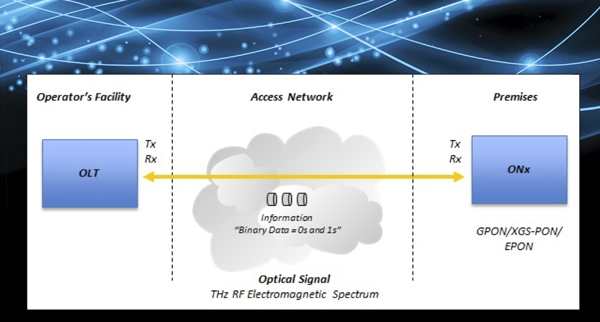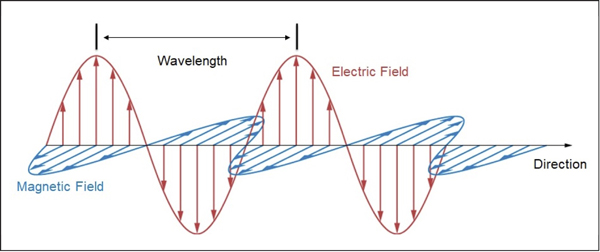What are Optical Signals?
By Steve Harris
You may have noticed that optical fiber has been more abundant in our access networks over the last few years. Operators are creating the next generation access networks to deliver 10G and beyond. The industry has deployed distinct networks that have leveraged additional optical signals like fiber to the x (FTTx), fiber deep, and distributed access architecture (DAA) networks. Remember, HFC has been using optical signals for quite some time now. There are numerous reasons for fiber deployments: less attenuation (loss) than copper (e.g., coaxial cable), less weight than copper cabling, reduced deployment cost, information capacity (50 THz), and immunity to electromagnetic radiation. Furthermore, optical signals using single mode fiber are able to propagate tens of kilometers (km) without amplification.
A common misconception is that optical signals and radio frequency (RF) signals are not related. Both optical and RF signals are part of the electromagnetic spectrum, with RF having longer wavelengths and lower frequencies than optical signals. The RF part of the electromagnetic spectrum is in the roughly 3 kHz to 300 GHz range, while light (infrared, visible, and ultraviolet) is in the roughly 300 GHz to 30 PHz range. Our cable networks operate in the MHz and lower GHz range, and our fiber links in the THz range. Previous knowledge of RF in the coaxial domain provides a strong foundation for those who will be working in the optical domain. For our telecommunications networks, optical communication to the premises occurs when a bidirectional optical link is established over the access network. The link is used to pass information in the form of optical signals between a transmitter and receiver. For example, in fiber to the home (FTTH) a telecommunication operator’s facility will transmit optical signals from the optical line terminal (OLT) to the customer premises’ optical network device (ONx) where they are received. The link in this example is sending information as an optical signal over the access network using pulses of light generated by a laser.
Optical signals are electromagnetic (EM) energy waves, or EM radiation. The EM spectrum includes RF, light, X-rays, and gamma rays. The optical signals in the EM spectrum comprise oscillating electric fields and magnetic fields that are orthogonal to one another, traveling in a particular direction as shown in Figure 1.

Figure 1. Optical signals over a FTTH network
From the early days of a person’s career in telecommunications they know the higher the frequency the greater the loss of energy. The good news is that the loss in optical fiber is much less per unit length than coaxial cabling, making optical fiber ideal for achieving a long signal distance (km) with low attenuation. When working with optical signals, the wavelength (e.g., 1550 nm) is used instead of its frequency. One reason is that optical signals use light, and this is defined by wavelength. A wavelength is shown in Figure 2, the distance between the peaks of an electromagnetic wave. The wavelengths for optical signals are shorter due to their higher frequency, expressed in nanometers (10-9 meter). A nm is a unit of length that is equivalent to a billionth of a meter. Finally, wavelength and frequency are inversely related, as wavelengths increase, frequency decreases. For example, 1490 nm is a lower frequency than 1290 nm as shown in Figure 3.

Figure 2. An electromagnetic signal

Figure 3. Inverse relationship of wavelength and frequency
Light is EM energy waves that travel through free space at about 3 x 108 m/s. To harness the power of light for transmitting information, a channel or wave guide in the form of optical fiber is used to transmit information over an access network. Furthermore, all optical signals in telecommunications must be encoded with the information to be transmitted (e.g., TDM = time division multiplexing) before they are transmitted and then decoded before the information is to be received by customer premises equipment (CPE).
In today’s access networks we use three main types of optical signals. The first type is the analog optical signal, simply referred to as analog intensity modulation (AIM). AIM is used to modulate (“encode”) the optical signal with RF before it is transmitted over the link in an HFC network or fiber deep network. A second type of optical signal is digital, often referred to as baseband digital. In digital, the optical signal is encoded using baseband digital modulation. Digital optical signals use binary coding to transmit a series of bits across an optical link as shown in Figure 4. Digital optical signals are common in FTTH EPON and GPON, as well as DAA networks. The last type of optical signals are coherent optical signals. These signals are encoded using amplitude like AIM, as well as phase. In addition, polarization is used, allowing an operator to send significantly more bits simultaneously across a link. Coherent optics are common in a core network or backbone network that can scale to 400G and may one day find their way into the access network.

Figure 4. Baseband digital modulation
Now that we understand the basics of an optical signal, it is equally important to understand that optical signals must maintain at a particular power level. For example, a FTTH transmitter may use a power level (e.g., +2 dBm @ 1490 nm) at the facility to send an optical signal across the access network to a receiver (ONx). The power level at the transmitter is determined by the optical power budget of the access network. Refer to my previous article “How Do We Use Optical Power Budgets?” for understanding and calculating a budget.
In my next 2022 article this summer we will explore how to measure, troubleshoot, and maintain optical signals. This article will explore fiber scopes, visual fault locators (VFL), optical power meters, optical time domain reflectometers (OTDR), optical spectrum analyzers (OSA), and optical signal to noise ratio (OSNR) measurements. For now, keep learning all you can about optical signals, as telecommunication operators will continue to expand the fiber footprint!
 Steven Harris
Steven Harris
Executive Director, Technical Sales, Learning & Development, SCTE
Steve is an international SME and thought leader, and the executive director of education and business development for SCTE. He is responsible for overseeing the architecture and evolution of educational programs, credentialing, and customized career progressions, as well as business development and partnerships. His team is responsible for an education library that is now 900+ modules, designed to drive business results. With more than 30 years in education, he has taught much of the content of the library, with a dynamic approach to the delivery of highly complex topics.



